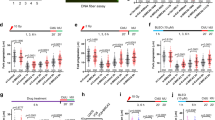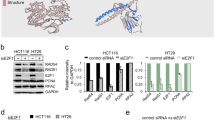Abstract
Bcl-2 stimulates mutagenesis after the exposure of cells to DNA-damaging agents. However, the biological mechanisms of Bcl-2-mediated mutagenesis have remained largely obscure. Here we demonstrate that the Bcl-2-mediated suppression of hMSH2 expression results in a reduced cellular capacity to repair mismatches. The pathway linking Bcl-2 expression to the suppression of mismatch repair (MMR) activity involves the hypophosphorylation of pRb, and then the enhancement of the E2F–pRb complex. This is followed by a decrease in hMSH2 expression. MMR has a key role in protection against deleterious mutation accumulation and in maintaining genomic stability. Therefore, the decreased MMR activity by Bcl-2 may be an underlying mechanism for Bcl-2-promoted oncogenesis.
This is a preview of subscription content, access via your institution
Access options
Subscribe to this journal
Receive 12 print issues and online access
$209.00 per year
only $17.42 per issue
Buy this article
- Purchase on Springer Link
- Instant access to full article PDF
Prices may be subject to local taxes which are calculated during checkout








Similar content being viewed by others
References
Tsujimoto, Y., Cossman, J., Jaffe, E. & Croce, C. M. Involvement of the bcl-2 gene in human follicular lymphoma. Science 228, 1440–1443 (1985).
McDonnell, T. J. & Korsmeyer, S. J. Progression from lymphoid hyperplasia to high-grade malignant lymphoma in mice transgenic for the t(14;18). Nature 349, 254–256 (1991).
Binder, C. et al. Bcl-2 protein expression in breast cancer in relation to established prognostic factors and other clinicopathological variables. Ann. Oncol. 6, 1005–1010 (1995).
Kaklamanis, L. et al. Early expression of bcl-2 protein in the adenoma-carcinoma sequence of colorectal neoplasia. J. Pathol. 179, 10–14 (1996).
Crowson, A. N., Magro, C. M., Kadin, M. E. & Stranc, M. Differential expression of the bcl-2 oncogene in human basal cell carcinoma. Hum. Pathol. 27, 355–359 (1996).
Yin, D. X. & Schimke, R. T. Inhibition of apoptosis by overexpressing Bcl-2 enhances gene amplification by a mechanism independent of aphidicolin pretreatment. Proc. Natl Acad. Sci. USA 93, 3394–3398 (1996).
Kuo, M. L., Shiah, S. G., Wang, C. J. & Chuang, S. E. Suppression of apoptosis by Bcl-2 to enhance benzene metabolites-induced oxidative DNA damage and mutagenesis: A possible mechanism of carcinogenesis. Mol. Pharmacol. 55, 894–901 (1999).
Liu, Y., Naumovski, L. & Hanawalt, P. Nucleotide excision repair capacity is attenuated in human promyelocytic HL60 cells that overexpress BCL2. Cancer Res. 57, 1650–1653 (1997).
Saintigny, Y., Dumay, A., Lambert, S. & Lopez, B. S. A novel role for the Bcl-2 protein family: specific suppression of the RAD51 recombination pathway. EMBO J. 20, 2596–2607 (2001).
Mitra, S. & Kaina, B. Regulation of repair of alkylation damage in mammalian genomes. Prog. Nucleic Acid Res. Mol. Biol. 44, 109–142 (1993).
Pegg, A. E. & Byers, T. L. Repair of DNA containing O6-alkylguanine. FASEB J. 6, 2302–2310 (1992).
Yang, J. L., Hu, M. C. & Wu, C. W. Novel mutational spectrum induced by N-methyl-N′-nitro-N-nitrosoguanidine in the coding region of the hypoxanthine (guanine) phosphoribosyltransferase gene in diploid human fibroblasts. J. Mol. Biol. 221, 421–430 (1991).
Duckett, D. R. et al. Human MutSα recognizes damaged DNA base pairs containing O6-methylguanine, O4-methylthymine, or the cisplatin-d(GpG) adduct. Proc. Natl Acad. Sci. USA 93, 6443–6447 (1996).
Chang, D. K., Ricciardiello, L., Goel, A., Chang, C. L. & Boland, C. R. Steady-state regulation of the human DNA mismatch repair system. J. Biol. Chem. 275, 18424–18431 (2000).
Jiricny, J. Replication errors: challenging the genome. EMBO J. 17, 6427–6436 (1998).
Modrich, P. & Lahue, R. Mismatch repair in replication fidelity, genetic recombination, and cancer biology. Annu. Rev. Biochem. 65, 101–133 (1996).
Hsieh, P. Molecular mechanisms of DNA mismatch repair. Mutat. Res. 486, 71–87 (2001).
Huang, D. C., O'Reilly, L. A., Strasser, A. & Cory, S. The anti-apoptosis function of Bcl-2 can be genetically separated from its inhibitory effect on cell cycle entry. EMBO J. 16, 4628–4638 (1997).
Yin, X. M., Oltvai, Z. N. & Korsmeyer, S. J. BH1 and BH2 domains of Bcl-2 are required for inhibition of apoptosis and heterodimerization with Bax. Nature 369, 321–323 (1994).
Adams, J. M. & Cory, S. The Bcl-2 protein family: arbiters of cell survival. Science 281, 1322–1326 (1998).
Helin, K., Harlow, E. & Fattaey, A. Inhibition of E2F-1 transactivation by direct binding of the retinoblastoma protein. Mol. Cell. Biol. 13, 6501–6508 (1993).
Graninger, W. B., Seto, M., Boutain, B., Goldman, P. & Korsmeyer, S. J. Expression of Bcl-2 and Bcl-2-Ig fusion transcripts in normal and neoplastic cells. J. Clin. Invest. 80, 1512–1515 (1987).
Ohtani, K., DeGregori, J. & Nevins, J. R. Regulation of the cyclin E gene by transcription factor E2F1. Proc. Natl Acad. Sci. USA 92, 12146–12150 (1995).
Vairo, G. et al. Bcl-2 retards cell cycle entry through p27Kip1, pRB relative p130, and altered E2F regulation. Mol. Cell. Biol. 20, 4745–4753 (2000).
Iwahashi, Y. et al. Promoter analysis of the human mismatch repair gene hMSH2. Gene 213, 141–147 (1998).
Polager, S., Kalma, Y., Berkovich, E. & Ginsberg, D. E2Fs up-regulate expression of genes involved in DNA replication, DNA repair and mitosis. Oncogene 21, 437–446 (2002).
Ren, B. et al. E2F integrates cell cycle progression with DNA repair, replication, and G2/M checkpoints. Genes Dev. 16, 245–256 (2002).
Chellappan, S. P., Hiebert, S., Mudryj, M., Horowitz, J. M. & Nevins, J. R. The E2F transcription factor is a cellular target for the RB protein. Cell 65, 1053–1061 (1991).
Harbour, J. W. & Dean, D. C. The Rb/E2F pathway: expanding roles and emerging paradigms. Genes Dev. 14, 2393–2409 (2000).
Brady, H. J., Gil-Gomez, G., Kirberg, J. & Berns, A. J. Bax α perturbs T cell development and affects cell cycle entry of T cells. EMBO J. 15, 6991–7001 (1996).
Linette, G. P., Li, Y., Roth, K. & Korsmeyer, S. J. Cross talk between cell death and cell cycle progression: BCL-2 regulates NFAT-mediated activation. Proc. Natl Acad. Sci. USA 93, 9545–9552 (1996).
Gil-Gomez, G., Berns, A. & Brady, H. J. A link between cell cycle and cell death: Bax and Bcl-2 modulate Cdk2 activation during thymocyte apoptosis. EMBO J. 17, 7209–7218 (1998).
Lind, E. F. et al. Bcl-2-induced changes in E2F regulatory complexes reveal the potential for integrated cell cycle and cell death functions. J. Immunol. 162, 5374–5379 (1999).
Greider, C., Chattopadhyay, A., Parkhurst, C. & Yang, E. BCL-xL and BCL2 delay Myc-induced cell cycle entry through elevation of p27 and inhibition of G1 cyclin-dependent kinases. Oncogene 21, 7765–7775 (2002).
Stein, G. H., Beeson, M. & Gordon, L. Failure to phosphorylate the retinoblastoma gene product in senescent human fibroblasts. Science 249, 666–669 (1990).
Krtolica, A., Parrinello, S., Lockett, S., Desprez, P. Y. & Campisi, J. Senescent fibroblasts promote epithelial cell growth and tumorigenesis: a link between cancer and aging. Proc. Natl Acad. Sci. USA 98, 12072–12077 (2001).
DePinho, R. A. The age of cancer. Nature 408, 248–254 (2000).
Yamasaki, L. et al. Tumor induction and tissue atrophy in mice lacking E2F-1. Cell 85, 537–548 (1996).
de Wind, N., Dekker, M., Berns, A., Radman, M. & te Riele, H. Inactivation of the mouse Msh2 gene results in mismatch repair deficiency, methylation tolerance, hyperrecombination, and predisposition to cancer. Cell 82, 321–330 (1995).
Hemminki, A. et al. Loss of the wild type MLH1 gene is a feature of hereditary nonpolyposis colorectal cancer. Nature Genet. 8, 405–410 (1994).
Fishel, R. et al. The human mutator gene homolog MSH2 and its association with hereditary nonpolyposis colon cancer. Cell 75, 1027–1038 (1993).
Drummond, J. T., Li, G. M., Longley, M. J. & Modrich, P. Isolation of an hMSH2–p160 heterodimer that restores DNA mismatch repair to tumor cells. Science 268, 1909–1912 (1995).
Vogelstein, B. & Kinzler, K. W. (eds) The Genetic Basis of Human Cancer (McGraw-Hill, New York, 1998).
Jiricny, J. & Nystrom-Lahti, M. Mismatch repair defects in cancer. Curr. Opin. Genet. Dev. 10, 157–161 (2000).
Umar, A. et al. Correction of hypermutability, N-methyl-N′-nitro-N-nitrosoguanidine resistance, and defective DNA mismatch repair by introducing chromosome 2 into human tumor cells with mutations in MSH2 and MSH6. Cancer Res. 57, 3949–3955 (1997).
Drummond, J. T., Li, G. M., Longley, M. J. & Modrich, P. Isolation of an hMSH2–p160 heterodimer that restores DNA mismatch repair to tumor cells. Science 268, 1909–1912 (1995).
Thomas, D. C., Umar, A. & Kunkel, T. A. Measurement of heteroduplex repair in human cell extracts. Methods 7, 187–197 (1995).
Takahashi, Y., Rayman, J. B. & Dynlacht, B. D. Analysis of promoter binding by the E2F and pRB families in vivo: distinct E2F proteins mediate activation and repression. Genes Dev. 14, 804–816 (2000).
Srivenugopal, K. S., Mullapudi, S. R., Shou, J., Hazra, T. K. & Ali-Osman, F. Protein phosphorylation is a regulatory mechanism for O6-alkylguanine-DNA alkyltransferase in human brain tumor cells. Cancer Res. 15, 282–287 (2000).
Acknowledgements
This work was supported by the Ministry of Science and Technology of Korea and the Korea Science and Engineering Foundation through the Research Center for Proteineous Materials, and was supported by the Molecular and Celluar BioDiscovery Research Program grant from the Ministry of Science and Technology, South Korea. We thank J. S. Valentine (University of California) for the Bcl-2 cDNA; W. G. Kaelin Jr (Harvard Medical School, Boston) for the pCMV–E2F1-Y411C plasmid; W. Heyns (Catholic University of Leuven, Leuven, Belgium) for the E2F reporter construct; S.J. Korsmeyer (Washington University School of Medicine) for Bcl-2G145A; S. Cory and J. Adams (The Walter and Eliza Hall Institute of Medical Research, Australia) for the Bcl-2Y28A; T.H. Kim for Bcl-XL cDNA (Chosun University School of Medicine, Korea); C. Thomas and A. Kunkel (National Institutes of Health) for HCT116 and HCT116-chr3; A. L. Epstein (University of Southern California) for SU-DHL-9, SU-DHL-6 and SU-DHL-4; and R. Boland (University of California) for HEC59 and HEC59-chr2.
Author information
Authors and Affiliations
Corresponding author
Ethics declarations
Competing interests
The authors declare no competing financial interests.
Supplementary information
Supplementary Information
Fig S1, Fig S2, Fig S3, Fig S4 (PDF 106 kb)
Rights and permissions
About this article
Cite this article
Youn, CK., Cho, HJ., Kim, SH. et al. Bcl-2 expression suppresses mismatch repair activity through inhibition of E2F transcriptional activity. Nat Cell Biol 7, 137–147 (2005). https://doi.org/10.1038/ncb1215
Received:
Accepted:
Published:
Issue Date:
DOI: https://doi.org/10.1038/ncb1215



